Visiting By Air
& Use of Drones
Arrivals by Air
Powered movements are not generally permitted at Dunstable unless strictly in connection with gliding business and subject to PPR
For private pilots transiting the Luton Zone, if informed that Dunstable is active, we simply ask that whenever possible, you try to avoid overflying the site below 2500ft QNH and try to keep 1 mile (~1.6km) away due to the intensive nature of the operations around the airfield.
Dunstable Airfield is an unlicensed private airfield
where gliding operations take priority at all times.
The airfield surface and topography is uneven and whilst the grass is kept to manageable lenghts it is not maintained to the standards of a fully licensed airfield. Therefore the surface may present unseen obstacles particularly with regards to the surface itself as in places it can be very rough.
Due to the clubs proximity to London Luton Airport (LLA), approx 10km to our East, the airfield is situated within the Class D Airspace that surrounds LLA.
This means that all flying activities from the club are conducted within certain areas of this airspace and are governed by a Letter of Agreement. This is held between the club, LLA, the National Air Traffic Service (NATS) and the CAA. The Dunstable Hangliding and Paragliding Associatoin as well as RAF Halton are also stakeholders in this agreement. The club wishes to maintain its good relationship it has with other airspace stakeholders.
Therefore any and all visits to the club by air are strictly PPR.
Requests for PPR will only be granted in advance and the relevant contact at the London Gliding Club will ensure that the visit is for legitimate club business and will ensure that the pilot is appropriately briefed.
Use of Drones
When thinking about how close you can fly, remember:
You must never endanger people, or the safety of an aircraft.
We are very fortunate that we can enjoy the Chilterns AONB from the air, as anyone who has flown with us will no doubt agree. We also appreciate the growing desire for everyone to have a picture of those views, particularly from the vantage point atop the Dunstable Downs.
We also recognise that there is an increasing use of small, privately owned drones to capture such views. We therefore kindly ask that all operators of drones close to the airfield have gone through the correct processes to obtain the landowners permission from where they intend to launch and are also aware of the rules and regulations regarding drone flying in the UK.
We like to hear from conscientious drone operators about your flight plan if operating nearby. Please send your flight details to: reception@londonglidingclub.co.uk
In terms of general information, please be aware that:
We typically operate from 10:00 until 18:00, however can fly sometimes from 30 minutes before sunrise and 30 minutes after sunset;
Gliders have unpredictable flight paths;
Takeoffs and landings can happen in any direction;
The airfield may seem quiet at times, but gliders are (mostly) silent! There may be gliders returning from flights from any direction, and they are difficult to spot; and
It is very difficult for gliders and our tow aircraft to spot drones due to their small size. It cannot be assumed that any aircraft has spotted a drone flying nearby.
The safety of all aviation is important to us and the London Gliding Club will take appropriate actions upon sighting a drone with unknown intentions that may have the potential to endanger persons or the safety of an aircraft.
We do not provide permission for the operation of drones from land owned by the London Gliding Club - Sorry, it’s just too risky for the safety our operations.
For any other information, please contact the club office or see the links below.
CAA Website Links:
Use of Drones in the UK
Use of Drones for Private Use / “Open” Category
National Trust Website:
Use of Drones from National Trust Property



